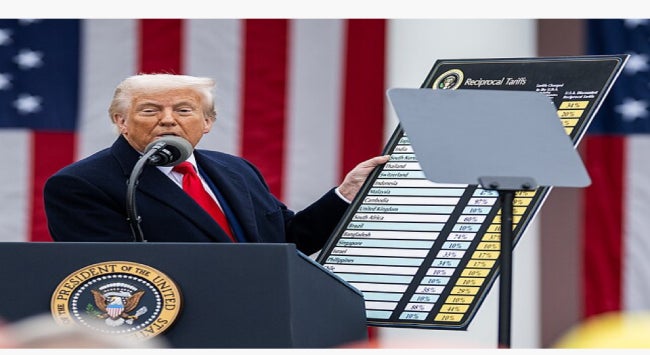Summary
Reciprocal tariffs mark the United States’ efforts to correct its global trade imbalances. India must note the geoeconomic implications of these tariffs and the tough policy reform demands they entail.
The United States’ (US) reciprocal tariffs, announced on 2 April 2025, have unleashed chaos and uncertainty. Global capital markets have gone into tailspins. There is widespread consternation over the impacts of the tariffs through their effects on national export prospects, supply chain management and global inflation.
US President Donald Trump has often identified India as one of the highest tariff countries in the world and has expressed disappointment over its trade barriers. Notwithstanding Trump describing Indian Prime Minister Narendra Modi as a ‘great friend’, the current bonhomie in India-US bilateral relations, and both countries negotiating a bilateral trade deal, India was not expected to avoid reciprocal tariffs. It has eventually been imposed a reciprocal tariff of 26 per cent.
India would not be particularly unhappy over a 26 per cent tariff. The fact that it has escaped tariffs of 30 per cent and above should be a source of comfort. Several Asian economies that are significant exporters to the US with large trade surpluses have been hit with higher tariffs. These include China (34 per cent), Indonesia (32 per cent) and Vietnam (46 per cent). South Korea and Japan have been imposed tariffs of 25 per cent and 24 per cent respectively. Furthermore, India’s neighbours in South Asia – Bangladesh, Pakistan and Sri Lanka – have been slapped with tariffs of 37 per cent, 29 per cent and 44 per cent respectively – making India the ‘least tariff-affected country’ in the region. India will also be relieved over pharmaceuticals – one of India’s major exports to the US – being exempted from reciprocal tariffs.
The relatively lower rate of tariff, compared with some of its major export competitors in the US market, explains the lack of panic in India’s response to the tariffs. While indicating that the impact of the tariffs is being studied, India has emphasised on early completion of the bilateral trade deal being negotiated with the US. The ostensible assumption in this regard is that a bilateral deal will enable Indian exports to get lower-tariff preferential access to the US market, improving its export prospects significantly.
There are, however, further implications of the reciprocal tariffs that need to be noted by India.
The reciprocal tariff rates announced for various countries, including India, have been fixed not just on the basis of their currently applied tariffs but also existing non-tariff trade barriers. These barriers are explained in the US Trade Representative report on the subject released a day before the reciprocal tariffs were announced. Non-tariff market access barriers for India are discussed in detail in the report. These barriers are those that the US considers ‘unfair trade practices’ and would want India to act upon. Several of these will come up for reform in their bilateral trade negotiations.
India had already begun reducing tariffs from the latest Union Budget announced earlier this year. It will not hesitate to cut more tariffs, particularly for the import of items like high-power motorcycles, electric vehicles and alcoholic beverages, as these are not essential imports. For some items, such as dairy products, however, it will be tough for India to cut tariffs due to domestic resistance. Otherwise, many of the tariffs that the US demands to be cut can be accepted by India.
India’s biggest problems in acquiescing to the US’ demands to remove trade barriers will be in non-tariff areas. These include allowing greater market access in politically sensitive areas like government procurement. Domestic enterprises, particularly small industrial units, enjoy distinct preferences in government procurement tenders, including defence procurements. Changing these preferences involves large political costs. There will also be similar costs in reducing agricultural subsidies and liberalising entry conditions for foreign professionals in India’s legal services market.
Going beyond what can be addressed through trade policy talks, India must note potential US demands to address its foreign exchange management policies. The US is keen on increasing the competitiveness of the US dollar by resisting the efforts of major global economies to devalue their currencies against the US dollar. This is premised on the thinking that the US’ global trade imbalances are majorly contributed by a heavily expensive US dollar. Trump’s earlier threat to impose heavy tariffs on the BRICS countries for preventing their attempts to destabilise the US dollar needs to be noted carefully by India in this regard.
Reciprocal tariffs are the US’ geoeconomic tools to achieve specific national security goals. This is clear from their being introduced in the context of a ‘national emergency’ arising from ‘large and persistent’ goods trade deficits. Their implications should be noted accordingly by all countries, including a large emerging market economy like India, which has to balance turfs between the major powers and fight the risks arising from a fast-eroding rules-based global trade order.
. . . . .
Dr Amitendu Palit is a Senior Research Fellow and Research Lead (Trade and Economics) at the Institute of South Asian Studies (ISAS), an autonomous research institute at the National University of Singapore (NUS). He can be contacted at isasap@nus.edu.sg. The author bears full responsibility for the facts cited and opinions expressed in this paper.
Images: https://commons.wikimedia.org/w/index.php?search=Trump+tariff&title=Special:MediaSearch&type=image
-
 More From :
More From :
-
 Tags :
Tags :
-
 Download PDF
Download PDF



